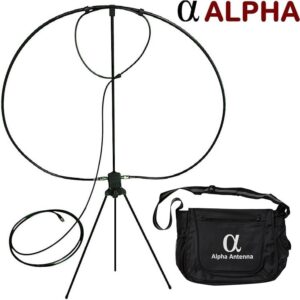How do you choose the best HF antenna?
Whether your obstacles are trees, buildings, operating indoors, or something else; HERE IS HOW TO choose an antenna that will work in your physical environment.When choosing the best HF antenna, first consider NVIS and DX objectives
The best HF Antenna that exhibits primarily NVIS characteristics will work well for Regional Communications. Regardless of whether the antenna is placed in a relatively clear area or in a heavily wooded area, NVIS is often still very possible. This is because directly above the antenna trees often provide less of an obstacle, enabling NVIS to still propagate skyward. We also know that the take-off angles needed for DX is significantly impacted in the same heavily wooded areas. This is because DX characteristics often rely on a low take-off angle to the horizon. The trees, however, produce significant obstacles between the antenna and the horizon.
This is why our Alpha Antenna MagLoop, HexTenna, or HD-FMJ systems are best when the horizons are not obstructed. So, a site where horizons are not obstructed provides opportunity to use antennas with a low take-off angle to enhance DX.
Antenna Efficiency
The HD-FMJ, HexTenna, and also the MagLoop all have the best HF antenna for a combined result of DX and NVS signal patterns. These three antennas are all portable ham radio antennas, meaning they are designed to be used anywhere.
The most efficient and largest antenna is the HexTenna antenna. This antenna requires you shorten or lengthen the Telescopic Elements with Tuning from one band to another. However, it does not cover 80 meters unless you add the Auto Match, which does lower efficiency.
The smallest and second most efficient antenna are the 10-40M and 10-80M MagLoop antennas. It requires you to turn a knob on the antenna to tune when changing bands. These first two antennas are very effective for even low power operations. This is because they have a higher efficiency Q rating. Having a higher Q rating means an antenna has a narrower bandwidth. To see an example of tuning, please fast forward to the 8-minute mark in the following video: Setup and Tuning one of the Legacy MagLoop antennas from Alpha
The third most efficient antennas are the 6-80M HD-FMJ antenna. This is the easiest system to use, as it provides hands-free operation, enabling you to just touch the button on your tuner when changing bands. Alternatively, you may choose to use one of our EFHW dipole antennas. Just keep in mind if you do, that they will have a Signal Pattern similar to half of a dipole.
Determining factors
Choosing the best HF antenna for your physical and operational needs will determine whether you can successfully communicate or not. So consider these things:
- What your own Physical limitations are,
- How much interaction you would like with an antenna,
- Antenna efficiency required to reach your target,
- Whether your target location requires NVIS or DX signal pattern,
- What the physical and environmental looks like where the antenna will be deployed.
The physical environment that surrounds antennas will have an impact on performance. Consider this when placing an antenna to enhance performance. Do not expect the same performance from an antenna indoor or antenna placed near a building as one that’s outside.
You will typically see about 1.75 S-Unit of loss when operating inside a stick build home. Performance in apartments can be significantly less in the direction through the building. So placement on a balcony or in-front of the largest window after removing any metal screen will help if indoors. Losses are also higher where the home’s exterior walls have a chicken type wire under stucco or that have aluminum siding.
So, which HF antenna should I get?
Some operators get two antennas; one for DX and one for NVIS. Other operators get one antenna, which can be deployed to either enhance DX or NVIS characteristics. The following antennas are categorized under three headings below. We hope that this guidance helps you to achieve your mission directive or personal goals.
See more Technical Articles
The following are the best HF antennas that have been selected and placed into 3 categories:
A) Enhanced NVIS and enhanced DX, B) Enhanced NVIS and some DX, and C) Enhanced DX and some NVIS
A) Best HF antennas for NVIS & DX
-
VHF UHF HF Antenna (EmComm MagLoop)$399.00Rated 4.99 out of 5 based on 99 customer ratings
-
2M 10-80M 440/900MHz GMRS CB Antenna (HOA Buster)$249.00Rated 4.90 out of 5 based on 110 customer ratings
-
2-40M+440 HF VHF UHF Antenna (HexTenna Deluxe)$600.00Rated 5.00 out of 5 based on 32 customer ratings
-
2-20M HF VHF Antenna (Yagi Deluxe)$800.00Rated 5.00 out of 5 based on 4 customer ratings
-
6-80M Portable HF Antenna (MIL EmComm Deluxe)$519.00Rated 4.97 out of 5 based on 112 customer ratings
-
10-80M HF Base Antenna (ProMaster)$600.00Rated 4.94 out of 5 based on 32 customer ratings
B) Best HF antennas for NVIS
-
6-80M HF End-Fed & CB Antenna (JPole Jr)Rated 5.00 out of 5 based on 68 customer ratings
-
10-160M End-Fed & CB Antenna (JPole Sr)Rated 4.99 out of 5 based on 81 customer ratings
-
10-160M Portable HF Antenna (MIL EmComm Enhanced)Rated 5.00 out of 5 based on 16 customer ratings
C) Best HF antennas for DX
-
6-80M Portable HF Antenna (MIL EmComm Deluxe)Rated 4.97 out of 5 based on 112 customer ratings
-
10-40M 100W (HF MagLoop) optional VHF UHF 6M or 60/80MRated 5.00 out of 5 based on 92 customer ratings
-
2-20M HF VHF Antenna (Yagi Deluxe)Rated 5.00 out of 5 based on 4 customer ratings











